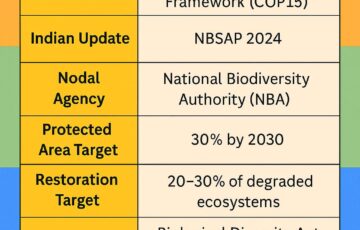AIR POLLUTION CONTROL: A CLIMATE DILEMMA
Syllabus:
GS-3:
- Climate Change
- Environmental phenomenon and Challenges
- Pollution and its effects
Why in the News?
- A 2024 study in Geophysical Research Letters warns that reducing aerosol emissions without cutting greenhouse gases could lead to sudden warming and extreme heat in polluted regions like India.
- The study highlights that aerosols counteract warming by reflecting sunlight, and their rapid removal could unmask greenhouse gas-induced warming, worsening climate-related challenges.
The Aerosol Impact: Understanding the Dual Role
- Greenhouse vs. aerosols: Greenhouse gases trap heat, causing warming, whereas aerosols scatter solar radiation, producing a cooling effect that can temporarily offset climate change effects.
- Regional differences: Unlike well-mixed greenhouse gases, aerosol distribution varies by location and time, meaning their impact on temperature and precipitation patterns is highly localized.
- Short-term effects: Aerosols persist for days to weeks, unlike carbon dioxide, which stays for centuries, making air pollution reduction immediately noticeable in temperature changes.
- Water cycle disruptions: Aerosols influence monsoon patterns by affecting cloud formation and precipitation, leading to complex climate interactions that are still being studied.
- Unexpected consequences: In regions like China, cutting aerosol emissions has intensified heat waves elsewhere, highlighting the interconnected global impact of aerosol reduction.
India’s Thermal Power and Pollution
- Coal dependence: Around 70% of India’s electricity comes from coal-fired plants, which emit sulphates, black carbon, and dust, significantly contributing to aerosol pollution levels.
- Flue gas treatment: Power plants use flue gas desulfurization to remove sulphur dioxide, but this also reduces cooling aerosols, potentially increasing local warming.
- Composition challenge: Sulphate aerosols form 50-60% of India’s pollution mix, making their reduction a major climate risk if not paired with greenhouse gas control.
- Health concerns: Besides climate impact, aerosols cause respiratory diseases, making their reduction an urgent public health priority despite warming risks.
- Balancing act: India must carefully transition to cleaner energy, ensuring emission reductions do not create unintended warming shocks.
Invisible Offset: How Aerosols Mask Warming
- Historical trends: Between 1906 and 2005, India warmed by 54°C, while greenhouse gases alone would have caused 2°C warming, showing aerosols’ strong cooling effect.
- Government findings: India’s average temperature rose 7°C from 1901-2018, with aerosols partially offsetting greenhouse gas-induced warming, delaying some climate risks.
- Scientific calculations: IIT-Delhi researchers estimate that without aerosols, India’s warming would be significantly higher, emphasizing their current climate buffering role.
- Comparative global impact: While the world has warmed by 3°C, India’s actual temperature rise is lower, primarily due to high aerosol emissions.
- Policy implications: Abrupt aerosol reductions could lead to rapid temperature spikes, making gradual and planned reductions essential for climate stability.
Aerosols and the Monsoon Cycle
- Temperature effects: Removing aerosols leads to warming, but their impact on rainfall patterns is more complex and region-specific.
- Northern vs. Southern Hemisphere: Aerosol cooling is stronger in the north, reducing Indian monsoon rainfall, but regional variations complicate predictions.
- Remote influences: Aerosols from India affect global climate, just as China’s emission cuts intensified Pacific heatwaves, showing cross-border climate connections.
- Ongoing studies: Researchers are still investigating how monsoon rainfall will respond if aerosol pollution declines, making future projections uncertain.
- Adaptation strategies: Understanding regional climate shifts will help India prepare for monsoon changes and avoid agricultural disruptions.
The Net-Zero Perspective and Future Strategies
- Beyond net-zero: Achieving carbon neutrality alone is not enough; policymakers must address adaptation challenges to protect vulnerable populations.
- Indo-Gangetic vulnerability: The Indo-Gangetic plains, with high aerosol pollution, could see severe warming spikes if emissions decline abruptly.
- Direct Air Capture (DAC): Is a climate technology that removes carbon dioxide directly from the atmosphere. The captured CO₂ can be stored underground (carbon sequestration), used in synthetic fuels for aviation, or utilized in industrial applications like food processing and plastic production, supporting low-carbon development and circular carbon economies.
- Heat action plans: Cities like Delhi, Mumbai, and Bengaluru lack long-term heat mitigation strategies, worsening risks for urban populations.
- Balancing health and climate: While cutting pollution improves air quality, it may intensify heat stress, requiring holistic climate adaptation policies.
- Policy recommendations: India must invest in better forecasting, regional climate studies, and gradual emission reduction strategies to balance health and climate objectives.
Challenges
- Conflicting environmental goals: Balancing air pollution reduction while preventing rapid warming creates a policy dilemma for decision-makers.
- Health vs. climate trade-off: Reducing aerosols improves air quality, but it also increases warming, making climate adaptation strategies more urgent.
- Regional variation in impact: Aerosol effects vary across different geographical regions, complicating efforts to design uniform mitigation policies.
- Energy transition constraints: India’s reliance on coal power makes a sudden shift to cleaner energy sources economically and technically challenging.
- Uncertainty in climate projections: The long-term climate effects of aerosol removal are still poorly understood, making it difficult to predict future risks
Way Forward
- Phased emission reduction: Implement gradual aerosol emission control to avoid sudden temperature spikes while shifting to cleaner energy sources.
- Improved climate adaptation plans: Develop robust heat action strategies and monsoon prediction models to safeguard vulnerable populations.
- Technological innovations: Invest in carbon capture and alternative cooling solutions to balance emissions reduction and climate stability.
- Strengthening policy frameworks: Introduce holistic climate policies that integrate air pollution control with long-term climate mitigation strategies.
- Enhancing global cooperation: Collaborate with international climate agencies to develop effective and equitable strategies for managing aerosol reductions.
Conclusion
India faces a critical challenge in balancing air pollution control and climate mitigation. While reducing aerosols is necessary for public health, it must be accompanied by coordinated greenhouse gas reduction strategies to prevent unintended climate consequences. A gradual, well-planned transition will ensure sustainable environmental policies that protect both climate stability and human well-being.
Source:
The Hindu
Mains Practice Question:
“India’s efforts to reduce air pollution could paradoxically lead to higher warming due to the masking effect of aerosols. Discuss the implications of this phenomenon and suggest a balanced policy approach to tackle both air pollution and climate change.”





